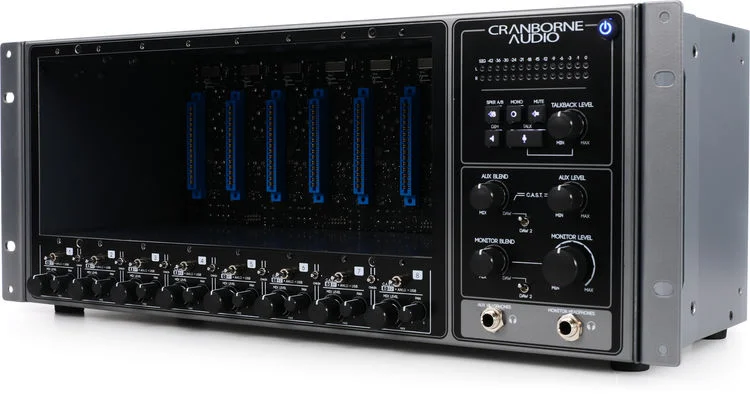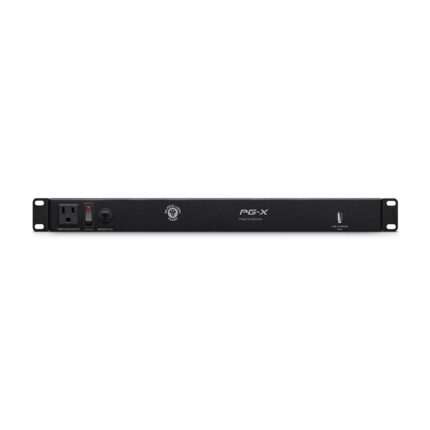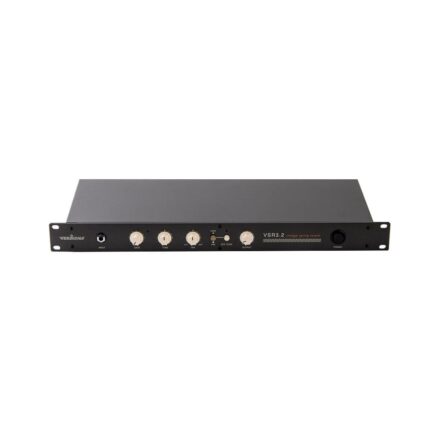| Content | Proven reverberation classic for the future
With the VSR 3.2, we happily rely on the proven old mechanical way to create reverberation. Rightly, because the used reverberation spring by AccuBell (formerly Accutronics) creates that magic 60's reverb which is slightly metallic and dense at the same time.
Just like it predecessors, VSR 3.2 has a straight-forward and honest approach: signal in - spring reverb - vintage sound out.
VSR 3.2 is equipped with an equalizer that is exactly adapted to the springs' frequency response. In addition, there are controls to mix the dry and effect signal as well as controls for the input and output level. This way, VSR 3.2 simply exactly does what it was designed to do.
Designed for every situation
Although using a large spring (type 9), VSR 3.2 fits in a 19" housing with one rack unit – minimal space requirements. Thanks to its extremely solid chassis, VSR 3.2 is a reliable vintage-effect that cannot only be used in a controlled studio environment. On the contrary, it also serves fine when being used in straining live situations.
VSR 3.2 grants your sound an elegant touch of "good old times". Its simplicity makes it an unbelievable versatile companion.
Inputs
- 1/4"-jack input front
- unbalanced
- max. input sensitivity: –40 dBu
- impedance: 1 MΩ
- 1/4"-jack input rear (1)
- unbalanced
- max. input sensitivity: 0 dBu
- impedance: 100 kΩ
- 1/4"-jack input rear (2)
- unbalanced
- max. input sensitivity: –20 dBu
- impedance: 10 kΩ
Outputs
- 1/4"-jack output (1)
- unbalanced
- max. output level: 0 dBu
- 1/4"-jack output (2)
- unbalanced
- max. output level: - 20 dBu
Signal-to-Noise Ratio
- direct: > 80 dBu
- effect: > 70 dBu
THD + Noise
Miscellaneous
- power supply: external DC-adapter with 12 V/1000 mA
- dimensions: 19“, 1 HE, ca. 190 mm deep
- weight: 2.5 kg
|
The Cranborne Audio 500R8 is, essentially, a studio in a rack. It’s an 8-slot high-current 500 Series chassis, a 28-in/30-out USB interface, an analog summing mixer, a zero-latency artist mixer, and a monitor controller — everything you need to build your dream hybrid analog/digital studio. The 500R8 is fitted with high-performance AD-DA conversion, reference-grade headphone amplifiers, a reference-quality master clock, and more. In fact, there’s very little you can’t do with the Cranborne Audio 500R8. Configure it to suit your preferred analog flavoring for any source. Pack it with vintage-style 500 Series preamps for recording drums; clean, pristine preamps for vocals; and EQ, compression, and saturation modules when it’s time for mixdown.
USB audio interface
Connect the 500R8 directly to your Mac or PC via USB and utilize the 500R8’s onboard 28-in/30-out USB audio interface for recording and playback directly to and from your digital audio workstation of choice.
Discrete summing mixer
Give your mix the crowning touch of analog character by sending submixes and stems back through your 500 Series modules, into the 500R8’s discrete analog summing mixer, and back into your DAW.
Monitor controller
Use the 500R8’s onboard high-headroom monitor controller to switch between two sets of speakers, toggle mono sum, mute, dim, and talkback facilities while monitoring the peak level of your mix on the high-resolution 28-segment LED meter.
 Shown with optional 500 Series modules Shown with optional 500 Series modules

Audiophile headphone amps and zero-latency artist mixer
Drive any headphones with 500R8’s two reference-grade headphone amplifiers — they have enough power to drive low-impedance ’phones with gobs of headroom and a linear frequency response to below 1Hz! Use the 500R8’s two aux buses to create pristine analog cue mixes that you can blend with DAW playback and send to the talent with zero latency.
World-class conversion and clocking
For the musician who wants to get down to business, it may be hard to get excited about conversion and clocking. But engineers at Sweetwater get to check out the best of them — and we’re amped about these converters. They’re touted as best-in-class and flaunt truly impressive specs such as under .5 picoseconds of jitter. But none of that really matters when you hear the fullness of your stereo image bloom with jaw-dropping sonic clarity.
Connect the 500R8 to your macOS or Windows computer and capture every nuance of your sources with reference-grade AD/DA conversion and world-class internal clocking. Effortlessly pass audio between analog and digital worlds without the digital artifacts that color, cloud, and degrade your recordings. The only coloration you will hear is intentional — your microphone placements, mixing decisions, and the 500 Series modules you’ve chosen to use. And with word clock I/O, you can even share the 500R8’s world-class clocking with the rest of your digital gear.
Ample I/O and configurable front end
The 500R8 has generous I/O to integrate with all of your analog and digital hardware, so you can mix and match your 500 Series modules and find the best combinations during recording and mixing to help create your own signature analog sound. You can even integrate your 19" rack units via the 500R8 s dedicated per-slot TRS insert jacks.
C.A.S.T. away
Spec’d with Cranborne’s innovative C.A.S.T. system, the 500R8 does away with excess cable spaghetti, delivering a cost-effective, low-maintenance, plug-and-play solution by transmitting four channels of balanced analog audio over shielded Cat 5 Ethernet cable directly to the destination of your choice.
Handy source select
Re-patch your 500R8 at a flick of a switch. Dedicated source select switches for each 500 Series slot adjusts signal routing to send analog, C.A.S.T., or USB sources through each of your modules. Unused 500 Series slots? Bypass them using the 500R8’s dedicated slot-bypass switch.
 Shown with optional modules and Cranborne 500ADAT Shown with optional modules and Cranborne 500ADAT
Expandable, in the studio or on the road
When you’re ready for additional 500 Series connectivity, connect your 500R8 with Cranborne Audio’s 500ADAT via ADAT for 16 channels of 500 Series modules. Housed in a 19" 4U rack-mountable rugged steel frame, the 500R8 makes an ideal 500 Series chassis for mobile recording setups. Packed with cool, useful features, the Cranborne Audio 500R8 is one of the more innovative pieces of pro audio gear we’ve seen at Sweetwater. Trust us — you will be impressed.
Cranborne Audio 500R8 8-slot 500 Series Chassis and USB Audio Interface Features:
- 28-in/30-out USB interface, summing mixer, artist mixer, and monitor controller
- Low-latency USB 2.0 interface:
- Compatible with macOS and Windows computers
- ADAT I/O (16x16 channels @ 44.1/48kHz, 8x8 channels @ 88.2/96kHz)
- S/PDIF I/O; 5-pin MIDI I/O
- High-performance A/D conversion:
- Dynamic range: 121dB A-weighted dynamic range, 20Hz–20kHz
- Frequency response: 2.2Hz to >80kHz (-1dB)
- THD+N: <0.00032% (-110dB) @ -4dBFS, 20Hz–40kHz (1kHz, A-weighted)
- Max input level: +24dBu
- High-performance D/A conversion:
- Dynamic range: 121dB A-weighted, 20Hz–20kHz
- Frequency response: <1Hz to >61kHz (-1dB)
- THD+N: <0.0003% (-110.5dB) @ -4dBFS, 20Hz–40kHz (1kHz, A-weighted)
- Max Output Level: +24dBu
- Reference-quality internal master clock:
- Sample rates: 44.1, 48, 88.2, 96, 176.4, and 192kHz; <0.5ps jitter
- Dedicated word clock I/O via BNC
- External sync options using word clock BNC, S/PDIF, or ADAT
- Monitor controller with talkback:
- Speaker A/B switching, mono check, dim, mute, and 28-segment peak meter
- Dedicated talkback input with phantom power, push-to-talk activation, and automatic routing to all headphone and C.A.S.T. facilities
- Easy-access illuminated front panel controls for all monitor controller functions
- Analog summing mixer:
- 8x2 analog summing mixer with +26.5dBu of headroom and dedicated ADC
- Balanced 1/4" jack outputs
- C.A.S.T. link port for increasing Summing Mixer to 16x2 using Cranborne Audio 500ADAT
- Zero-latency Artist Mixer:
- Analog Artist Mixer with per-channel physical level/pan controls and DAW return blend controls
- 2 high-power headphone outputs with independent blend and level controls
- Reference-grade headphone amplifier:
- THD+N: <0.0006% (-104.4dB) @ 20dBu, 1kHz A-weighted, 300 ohm load
- Output wattage (1kHz): 250mW x 2 @ 600 ohms, 650mW x 2 @ 220 ohms, 1.21W x 2 @ 100 ohms, 500mW x 2 @ 32 ohms
- Frequency Response: <1Hz to >70kHz (1dB)
- High-current 8-slot 500 Series rack:
- Per-slot current: 250mA , 2A total for all slots
- XLR inputs, XLR line outputs, and TRS Inserts (pre-ADC) per 500 Series slot
- Module source switching options to send Analog, USB or external C.A.S.T. signals through 500 Series modules
- Per-slot module bypass switches allowing 500R8 to be used without 500 Series modules installed
- C.A.S.T. compatible:
- C.A.S.T. ports per channel for routing analog I/O using passive or active C.A.S.T. breakout boxes via standard Cat 5 cable
- External power supply:
- 24V, 5A external locking power supply for improved analog audio performance and heat dissipation
- Designed and engineered in the UK:
- Each 500R8 is extensively tested by a team of dedicated engineers to ensure reliability and consistency.
| With a big, bold preamp, a swept high-pass filter and the powerful saturation control of variable Silk, the 511 combines legendary Rupert Neve tone with 500 Series value.
What is Silk?
One of the key features of the 511 is the Silk / Texture control. The Silk circuit was initially developed for the original Portico series mic preamplifiers, and was only a single switch – on or off – that added a specified amount of musical, pleasing harmonic saturation to the unit’s output stage.
Taking this concept one step further, the Texture knob is designed to adjust the actual amount of harmonic content from the source material.
So how does it work? By reducing negative feedback across the output transformer and adjusting this feedback’s frequency response, the Silk / Texture circuit provides the sweet, musical saturation found in Rupert’s legendary vintage designs – but with complete & precise control over the amount of classic tone you want.
NOISE
- Measured at Main Output, un-weighted, 22 Hz - 22 kHz, source impedance 150 Ohm balanced. Noise performance can vary depending on the 500 series and / or interference from stray magnetic fields.
- Unity Gain: Better than -103 dBV
- Gain @ +66 dB: Better than -60 dBV
- Equivalent Input Noise: -125 dB
FREQUENCY RESPONSE
- Main output, no load.
- +/- 0.1 dBu from 10 Hz to 31.5 kHz
- -2.6 dB @ 120 kHz
MAXIMUM OUTPUT LEVEL
+23 dBu
TOTAL HARMONIC DISTORTION AND NOISE, NO SILK
- @ 1 kHz, +20 dBu output level, no load: Better than 0.0025%
- @ 20 Hz, +20 dBu output level, no load: 0.025% Typical (2nd and 3rd harmonic)
TOTAL HARMONIC DISTORTION AND NOISE WITH SILK ENGAGED
- @ 100 Hz, +20 dBu input level, no load.
- TEXTURE @ min: 0.015%, mostly 3rd harmonic typical
- TEXTURE @ max: 2%, mostly 2rd harmonic typical
GAIN
- Unity up to +66 dB in 6 dB steps.
- Trim continuously adjustable from -6 dB to +6 dB.
PHANTOM POWER
Supplied by the 500 series rack power supply. Switch selectable on faceplate.
HIGH PASS FILTER
- Continuously variable swept frequency from 20 Hz to 250 Hz.
- Slope: 12 dB/Octave
POWER REQUIREMENTS
@ +/-16VDC, 100mA | Originally developed for the dynamics circuit of the acclaimed Shelford Channel, the 535 Diode Bridge Compressor captures the soul of Rupert Neve’s original 2254 compressor while providing modern updates including advanced timing control, significantly lower noise, fully stepped controls throughout, and internal parallel processing capabilities.
What is diode bridge compression?
Where the VCA compressor found in the Master Buss Processor provides unmatched clarity, the weighty, harmonically rich tonality of diode bridge compression can be essential in pushing key sources like vocals, electric guitars, bass and drums to the forefront of a mix.
By understanding the limitations of vintage units like the legendary 2254, painstaking effort was taken to reproduce the unique tone of these classics while improving the noise floor & accuracy, expanding inflexible time constants, adding full wave sidechain detection for improved dynamic response, and widening the range of threshold and ratio controls.
Delivering the powerful sound of these iconic designs with enhanced flexibility for the modern age, the 535 Diode Bridge Compressor is a dynamic tool equipped to make a bold statement on virtually any mix or track.
LINE INPUT TO LINE OUTPUT
- Compressor Bypassed.
- Z source = 40 Ohm Balanced
INPUT IMPEDANCE
10K Ohm
OUTPUT IMPEDANCE
40 Ohm
MAXIMUM INPUT LEVEL
+23.5 dBu
MAXIMUM OUTPUT LEVEL
+23.5 dBu
NOISE
- 22 Hz - 22 kHz BW.
- -101 dBu
FREQUENCY RESPONSE
- 10 Hz - 120 kHz, 30ft Output XLR Cable.
- +/- 0.25 dB
THD+N
- @ 1 kHz @ Maximum Output Level, 22 Hz - 22 kHz BW.
- 0.001%
| Effective against boredom, supporting creative sound design
A unique team play of spring reverberation, analogue multimode filtering, distortion and VCA, modulated by an ultra fast LFO and an envelope that can be triggered in flexible ways – Retroverb Lancet offers a comprehensive arsenal of many-sided effects for different applications. The spectrum by far surpasses classic reverberation, filter sweeps or overdrive because you are able to tweak and bend any parameter fast and intuitively to your liking.
Retroverb Lancet will change the way you work with effects. It becomes part of your sound engine, fires it up and will end up as essential part of your sonic signature.
Source of effectiveness
We designed Retroverb Lancet in a way that it can perfectly handle signals of any kind: Guitars, basses, synthesizers, organs or microphones. On top of that, Retroverb Lancet allows you to create percussive sounds using its crash function.
Retroverb Lancet is a real jack of all trades with character, suited for adventurous sound designers and tinkerers.
Audio Input
- max. input sensitivity: –32 dBu
- impedance: 1 MΩ
Output
- max. output level: 20 dBu
- impedance: 600 Ω
Trigger- and CV-inputs
- audio trigger
- max. input sensitivity: –32 dBu
- impedance: 1 MΩ
- gate & CRASH
- external cv
Signal-to-Noise Ratio
- direct: > 80 dB
- effect (filter completely open, no reverb): > 75 dB
Spring Tank
- number of springs: 3
- reverbration decay: between 2.75 db and 4.00 s
Filter
- modes: 24-db-lowpass, 24-db-highpass, 12-db-bandpass
- modulations sources: envelope generator, envelope follower, external CV, LFO
LFO
- frequency range: 0.05 Hz … 300 Hz
- waveforms: ramp up, ramp down, square, sine, S&H, envelope generator
Envelope Generator
- modes: AD, ASR
- attack: 1 ms … 10 s
- decay/release: 1 ms … 15 s
Miscellaneous
- power supply: external DC-adapter with 12 V/1000 mA
- dimensions: 26 cm x 14.5 cm x 8 cm (width x depth x height)
- weight: 0.75 kg
Accessories
| Imagine having the power and flexibility of the OP-Z sequencer available to any other music equipment. Now you can, with the new oplab module - the magic link between OP-Z and the rest of the world. The oplab module is the first hardware expansion module for OP-Z. once mounted in the back of your OP-Z, you can use it to connect to any equipment using standard cv and gate, such as the pocket operator modular or any other modular system. It features three cv outs and one gate out, all programmable and playable from OP-Z. have your wall of modules sequenced from the palm of your hands. Use the po sync out to unleash the power of your regular pocket operators and have them play in sync with the rest of your setup. Even connect standard midi devices, using midi over 3.5 mm jack or the included midi over din adapter cable. Oplab features both midi in and out ports as well as trig in and out for other synthesizers and sequencers. |






















Reviews
There are no reviews yet.